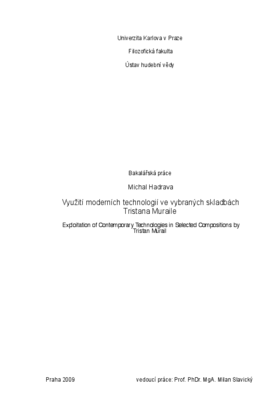Využití moderních technologií ve vybraných skladbách Tristana Muraile
Exploitation of contempory technologies in selected compositions by Tristan Murail
bakalářská práce (OBHÁJENO)

Zobrazit/
Trvalý odkaz
http://hdl.handle.net/20.500.11956/27167Identifikátory
SIS: 65987
Kolekce
- Kvalifikační práce [22841]
Autor
Vedoucí práce
Oponent práce
Pudlák, Miroslav
Fakulta / součást
Filozofická fakulta
Obor
Hudební věda
Katedra / ústav / klinika
Ústav hudební vědy
Datum obhajoby
17. 9. 2009
Nakladatel
Univerzita Karlova, Filozofická fakultaJazyk
Čeština
Známka
Výborně
V této práci je částečně zrekonstruován postup, jakým Tristan Murail komponoval skladbu Désintégrations, a postup, jakým komponoval Allégories. Následně je definován obecný model, který lze pozorovat na obou těchto postupech. Je ukázáno, že srovnání teorie témbru s tímto obecným modelem i samotný pojem "spektrum zvuku" vyvolávají otázku, jaký je vztah mezi sluchovým vjemem vybrané části Désintégrations nebo Allégories a vjemem zvuku, jehož spektrem byla tato část inspirována. Dále je ukázáno, že tento obecný model vyvolává i další otázku, totiž jaký je vztah mezi vjemem souzvuku, jehož tónové výšky jsou odvozeny z určité množiny frekvencí, a vjemem zvuku, jehož frekvenční složky mají kmitočty z té samé množiny. Poté jsou v hrubých rysech navrženy dva experimenty, jejichž účelem je zodpovězení těchto dvou otázek, a nakonec je zváženo, jestli tyto dva experimenty lze podle těchto návrhů realizovat.
At first, the compositional process of Tristan Murail's Désintégrations and the compositional process of his Allégories are partially reconstructed. Consequently, an abstract model, which applies to both of these compositional processes, is defined. It is demonstrated, that not only the comparison of the theory of timbre with this abstract model, but also the concept "spectrum of sound" itself leads to the question, what is the relation between an auditory percept of a part of Désintégrations or Allégories and an auditory percept of the sound, whose spectrum served as starting point for this part. Further, it is also demonstrated, that this abstract model leads to the question, what is the relation between an auditory percept of a chord, whose constituent pitches are derived from an aggregate of frequencies, and an auditory percept of a sound, whose partials have frequencies that have been taken from the same aggregate. Finally, the designs of two experiments, whose purpose is to answer these two questions, are outlined and the possibility of implementation of these two experiments examined.
